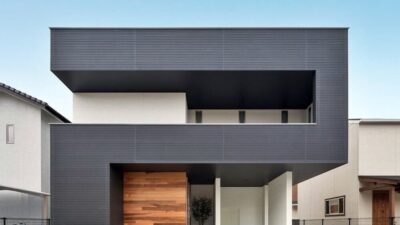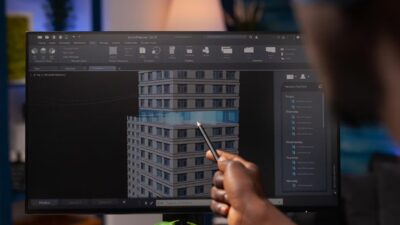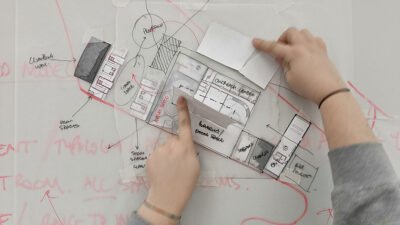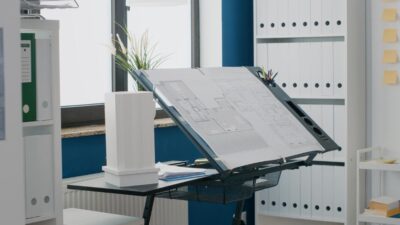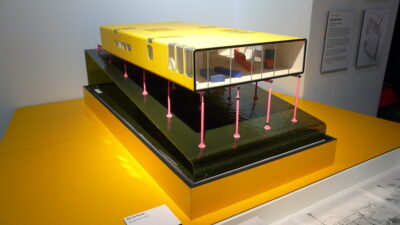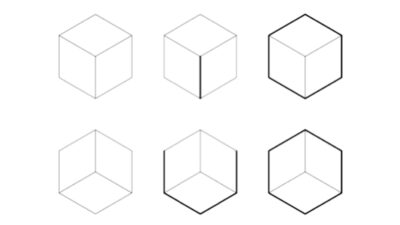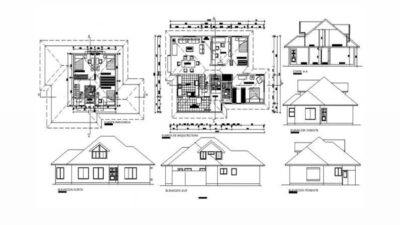This article explores how architects employ non-literal design techniques to conceptualize and communicate their visions. Unlike other art forms, architecture’s scale and complexity necessitate unique approaches to representation and ideation.
We will dissect the various methods in architectural practice and their significance in the architectural process, offering insights into how these practices shape our built environment.
Making Architecture
Architecture stands unique among creative fields. For instance, writers craft narratives on pages, forming books or plays. Dancers embody their performance through movement. Artists create tangible art through drawing or painting.
In contrast, architects do not directly create physical buildings. They produce representations that symbolize the envisioned structure. Grasping this concept is crucial.
Architectural creation differs markedly from other disciplines. Architects often lack the luxury of learning through direct physical creation due to the immense scale, time, financial resources, and collaborative efforts required.
Instead, they must master the art of depicting their final vision. This involves developing methods to visualize, evaluate, and articulate what the finished structure will embody.
Key Definitions:
- Representation: This involves depicting something through images, words, drawings, or symbols. Each representation serves as a stand-in for the actual object or concept;
- Abstract Art: This is the expression of a general idea or essence, rather than a direct depiction of reality. It utilizes elements like shape, color, line, texture, form, and light contrasts;
- Abstraction Process: This is the act of distilling an object or concept into its fundamental characteristics. It involves selectively revealing and concealing information to focus on the core message.
In architectural parlance, every communicative act is both abstract and representative. It isn’t the final structure but a portrayal of what the structure might entail. Each architectural rendering conveys a specific intention and meaning.
Before initiating any architectural diagram or other forms of depiction, it is essential to be clear on its purpose, the central message, and the most suitable method for its conveyance.
Reasons For Architectural Representation and Communication
The rationale behind various architectural representations evolves throughout the design, documentation, and construction phases. They include:
- Documentation: Recording existing conditions or finalized designs;
- Evaluation: Assessing various design alternatives;
- Process Recording: Tracing the evolution of design ideas;
- Persuasion: Convincing stakeholders of a proposed vision;
- Atmosphere Creation: Conveying the mood or feel of a space;
- Idea Explanation: Articulating architectural concepts;
- Relationship Mapping: Demonstrating connections between different elements;
- Instruction: Guiding the construction process;
- Archival Recording: Preserving the final design for posterity.
Types of Architectural Communication
- Written Documents: Encompassing letters, reports, emails, and contracts, these documents chronicle the project’s progression, from brainstorming to final approvals;
- Drawings: Two-dimensional visual representations, essential for conceptualizing designs;
- Sketches: Quick, preliminary drawings for capturing initial ideas;
- Diagrams: Simplified drawings illustrating concepts, relationships, or assembly processes;
- Mapping: Creating representations of existing spaces or features;
- Orthographic Drawings: Detailed, multi-view representations of three-dimensional objects in two dimensions, like house plans;
- Oblique and Perspective Drawings: Advanced techniques to visualize three-dimensional objects on a two-dimensional plane;
- Working Drawings: Comprehensive suites that detail the construction aspects, employing industry-standard symbols and conventions;
- Collage: A creative assemblage using diverse materials to form a new visual narrative;
- Physical Models: Scaled, tangible representations of the proposed architecture;
- Digital Models: Life-sized, digital representations, viewable in reduced forms on screens or prints;
- Photography: Capturing images as records or visual representations;
- Graphic Design and Presentation: Employing digital tools for layout and presentation of architectural work;
- Built Form: The ultimate, real-life three-dimensional experience of architectural design.
It’s All about Refinement and Adaptation
Communication is multifaceted, encompassing a wide array of mediums and skills. Each method serves as a vital tool for articulating architectural ideas and visions. As one progresses in their architectural journey, certain techniques may prove more effective in different project phases. Nevertheless, developing a diverse set of skills is imperative for a comprehensive communication toolkit.
For those embarking on architectural studies, the journey begins with familiar methods, gradually expanding into novel communication forms. As you advance, you will encounter the necessity to employ various techniques, such as collages, sketches, diagrams, or physical models. Embrace each new form as an opportunity to convey ideas uniquely and innovatively.
Rather than striving to create entirely new methods, focus on refining and adapting established techniques. Building a repository of examples and precedents is invaluable. This approach not only saves time but also inspires, allowing for a deeper understanding of how others have successfully communicated their architectural visions.
The Evolution of Architectural Communication
The field of architectural communication has undergone a significant evolution, adapting to technological advancements and changing design philosophies. Understanding this transformation is crucial for contemporary architects.
Key aspects of this evolution include:
- Transition to Digital Tools: The shift from hand-drawn sketches to digital modeling and rendering has revolutionized the way architects visualize and present their ideas;
- Integration of Virtual Reality (VR): VR technology has enabled architects to offer immersive experiences, allowing clients and collaborators to ‘walk through’ designs before they are built;
- Sustainable Design Communication: With a growing emphasis on sustainability, architects are increasingly required to illustrate how their designs minimize environmental impact;
- Collaborative Platforms: The rise of collaborative software has facilitated more efficient teamwork and communication among architects, engineers, and clients.
This ongoing evolution demands that architects remain adaptable, continually learning new tools and techniques to stay at the forefront of architectural communication.
Communicating Architectural Complexity
Conveying the intricacies of architectural designs can be challenging. A detailed understanding of both the artistic and technical aspects of a project is necessary for effective communication. This involves:
- Balancing Aesthetics and Functionality: Ensuring that visual presentations effectively convey both the aesthetic appeal and functional aspects of a design;
- Technical Precision: Architectural communication must be technically precise, as it often forms the basis for construction and engineering decisions;
- Client-Centric Approach: Tailoring communication to meet the specific needs and understanding of each client, ensuring clarity and comprehension.
As the field continues to evolve, mastering these communication skills becomes increasingly important. This is especially true in the context of diary design, where meticulous attention to detail and clear articulation of concepts are paramount.
Conclusion
This article has explored the nuanced and multi-faceted world of abstraction and representation in architectural communication. From the unique challenges architects face in conceptualizing and representing structures, to the diverse methods employed in articulating their visions, we have delved into the essence of architectural communication. We have seen how the field has evolved with technological advancements and the growing importance of sustainability. The balance of aesthetics and functionality, along with the precision required in technical communication, highlights the complexity and richness of this discipline.
As we have navigated through various aspects of communication in architecture, it becomes evident that an architect’s toolkit is both expansive and dynamic, requiring continuous learning and adaptation. The evolution from traditional to modern methods, the integration of digital technologies, and the importance of a client-centric approach underscore the ever-changing landscape of architectural communication.
Getting through the realm of architectural communication is full of constant discovery and adaptation. As the field evolves, so too must the architect, ever-ready to employ new tools and techniques to effectively convey their vision. This journey, intricate and demanding, is essential for the architect seeking to master the art of diary design and beyond, encapsulating the creative and technical prowess that defines the profession.



